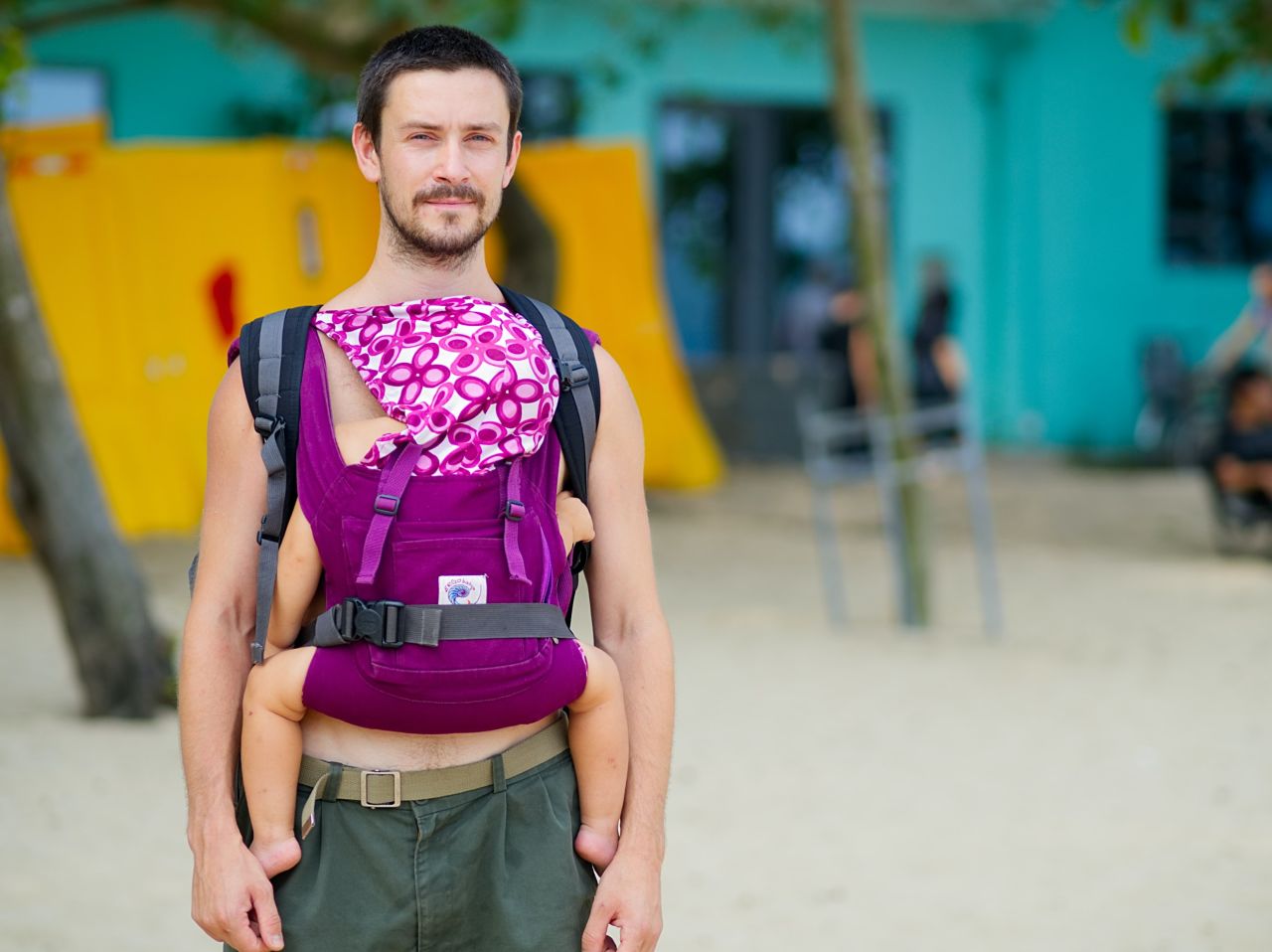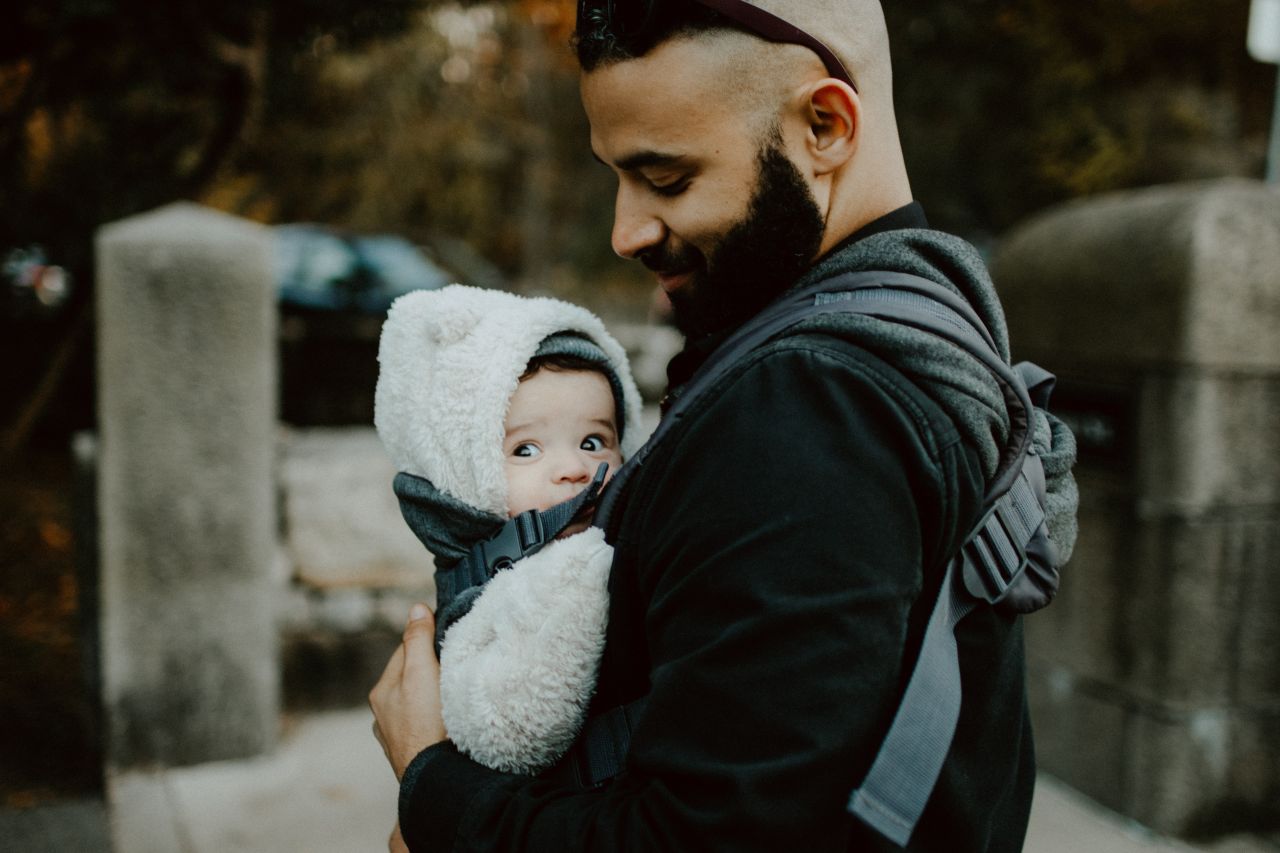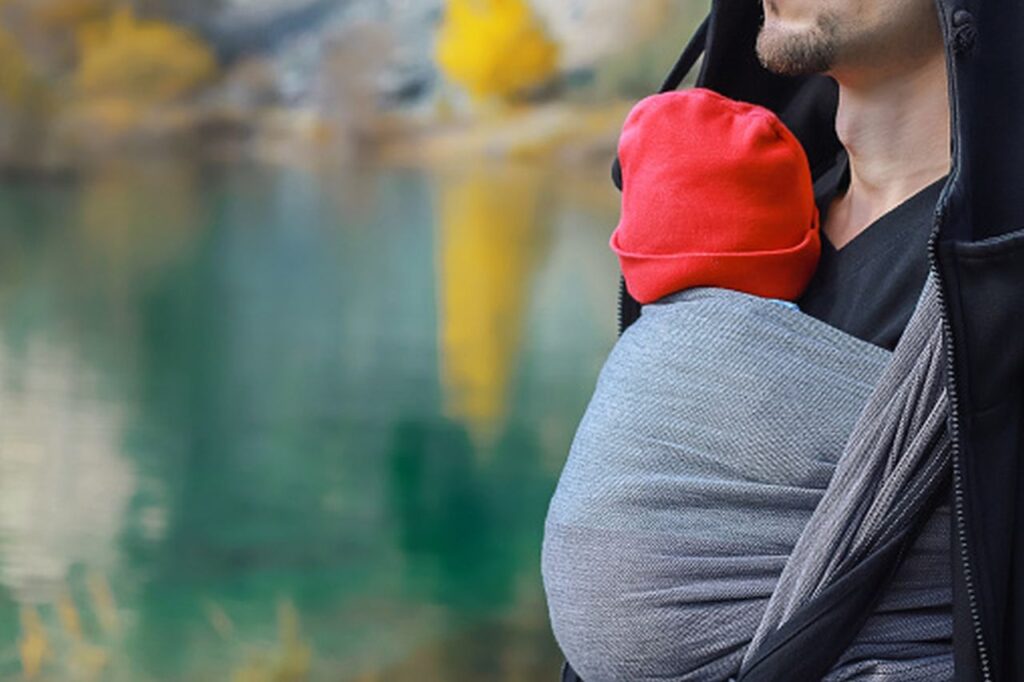There are so many wonderful benefits of babywearing. From supporting the baby’s natural posture to reducing infant crying, strengthening the bond between the baby and her caregivers and more, using a baby carrier is a win-win for you and your baby, emotionally, cognitively and physically.
But if you’ve never used a baby carrier, everything is new and unknown. What kind of ergonomic baby carrier should you use? When can you start using a baby carrier? What about baby carrier safety and hip dysplasia?
It’s a common question from many parents wondering if there’s a time limit or an age limit on the use of their carrier. With bub contently held close for a couple of hours, parents naturally get concerned if they should be taking their baby out of the one set position.
Babywearing has a more ‘natural’ time limit. That is, your baby will need to come out of the carrier at some point for a feed or a nappy change. Usually, the maximum they’d be in one would be for 2-3 hours before this ‘natural’ time limit kicks in.
If you’re carrying in the optimal position, with your baby’s spine naturally curved and their knees in the hip healthy M position with knees higher than bum, then this is a supportive position for the baby to be in for a couple of hours as it supports their natural anatomy and how they’d be held naturally in your arms against your chest anyways.
You might have heard the guidelines that a baby shouldn’t be left to sleep in a baby car capsule for hours on end in the one confined position. This guideline doesn’t translate across to babywearing as a car seat is a static environment. In contrast, when held in a carrier, your baby engages and responds to your movement, and you both adjust little positions accordingly.
Check out My Baby Nursery’s baby nursery sets to fit out your dream baby room.
How Long Should You Comfortably Carry Your Baby in a Carrier?

The precise answer is, one can carry a baby as long as they are happy and relaxed in it. Although this is the case, you should always ensure that you keep your baby contented at different stages. Contrarily, your baby carrier will hurt your baby rather than giving them the comfort they need.
Why Should You Carry Your Baby?
Some findings have revealed that carrying your baby has some amazing advantages. This is because it will promote strong ties between you and your kid. This is because as you carry them, they will be associating closely wherever you are going. Additionally, the kids will be exposed to what you are performing at any given time. Consequently, they will feed, nap and even mature, more superbly. To help you further, we shall talk about various types of carriers. More so, we shall see how they can be of great help to yours. With that, you will know the duration you can carry your baby depending on some factors.
A Comfortable Baby Carrier
Generally, a comfortable and well-designed baby carrier will allow you to carry your kid for a longer period. Further, it will allow you to conveniently slung the kid.
A conveniently slung kid will spend much time in a tranquil and observant state. He/she will observe and discover a lot of the person carrying them while carrying out their daily duties. Interestingly, they will only require to be put down when cleaning up, feeding and when sleeping.
It will help to manage the rhythms of the baby biologically. Usually, a baby senses their mother’s normal breathing as they are kept close to their chest. With the motherly guides, the baby can be calm and bring about a balancing effect. This is because the soothing rhythm of tones and moves that existed within the womb tends to come back.
If you are an overburdened mom, this will help you manage postpartum blues. Again, it can help the disabled parents to carry them for a long time without making the kid tired.
To give you a hint on the duration you can carry a baby in a carrier, let’s see the types. My Baby Nursery has a wide range of the best baby prams for you to choose from.
Types of Baby Carriers
Slings
These are designed from sheaths of strong but soft fabric. They are worn across one of the shoulders and over the body, wrapping newborns in a cradling bag. It features a buckle system or dual ring to resize the folds or die down the ends. These are ideal for small babies. This is because small kids will cuddle into their smooth fabric, thus not getting tired easily.
How Long Can You Carry a Baby in a Sling?
Newborns to 5 months
A sling holds your baby in an ergonomically good position which is snug and comfy. A small baby will sleep happily in a sling for hours. Mothers find that they only take their newborn out for a feed every couple of hours, the rest of the time, the little one usually sleeps.
As for how long you can carry your baby in a sling, the answer is for as long as he is happy in it. You don’t need to worry that you are spoiling your child if he spends hours in his baby carrier. According to the American Academy of Pediatrics, holding a baby in the early months helps them to feel safe.
5 Months to 18 Months
The same guidelines apply for slings as for wraps. A toddler who is accustomed to a sling will willingly sit in it for hours provided they can look out and see what’s going on around them.
You can be sure that if your child becomes too hot or uncomfortable for whatever reason, he will let you know.
18 Months to 36 Months
Toddlers of 18 months usually love their slings and will spend hours in it, but by the time a child reaches 36 months, they weigh quite a bit. A sling can still be used for carrying older toddlers, but you’ll probably find that the time spent in the sling becomes shorter. Partly because nap times are less frequent and partly because your back is complaining about the weight.
How long you can carry an older toddler in a sling will depend on you and your child. Use your discretion, but again, keep in mind that toddlers should have ample opportunity to run around and explore.
Wraps
Ordinarily, this is a one-piece fabric that goes across the two shoulders. Normally, it operates by simply enveloping both bodies together. Wraps are the adaptable and low-priced garments that will enable you to fasten your kid in different ways. These will include some of the most convenient bearing positions that will make a baby contented for long. For instance, a wrap like Baby K’ Tan can pleasantly carry a baby many hours. Its snug fit wraparound gives support for delicate spines necks and spines like that of babies.
How Long Can You Carry a Baby in a Wrap?
Newborns to 5 months
Small babies will stay happy in a wrap for hours on end. A wrap creates a little cradle for them that they seem to find comforting.
Newborns wake up to feed every two hours so that they will be taken out of the wrap regularly as a matter of course. As they start to sleep longer, they can stay in the wrap until they get restless.
At any rate, as soon as the baby feels uncomfortable, he will let you know.
5 Months to 18 months
These babies can hold their heads steady, and they are now interested in their environment. You would think that they won’t stay in a wrap for too long, but babies who are used to a wrap usually spend many happy hours in it.
Mothers report that their 18-month-old children habitually fall asleep in their wraps.
The rule of thumb is the child can stay in the wrap for as long as he and the wearer are happy and comfortable. Some mothers wear their babies for many hours in the day as it’s a practical, simple way to look after a baby.
18 Months to 36 Months
As all parents know, these toddlers have endless energy; they are on the go all the time. The chances are that they won’t want to be in a wrap for hours on end.
Besides, a 3-year-old weighs between 26 and 40 pounds – not a weight you want to carry around for hours while you’re doing chores. Although you can definitely carry a 3-year-old in a wrap, it is not the most comfortable choice for that age. Also, children of that age should be active; they should not be held immobile in a baby carrier for hours.
You can wear your toddler in a wrap for as long as they are happy in it, but do remember that a child of that age should be running around (although it’s tiring for you).
Soft-Structured Carriers
Generally, backpacks or Soft-structured carriers are square where they include pouches. They are commonly based on the popular Mei Tai-style idea from Asia. Typically, they have padding that is fastened into the bottom for a stronger seat. Additionally, it has dual shoulder bands and buckles for backpack-style makes. These are the common carriers that have been there for long. They provide different carrying styles that one can choose from. But when can baby face forward in a carrier? Well, that will be based on the baby’s development and age. However, the recommended age is between 4 to 6 months for both the carrier.
How Long Can You Carry a Baby in a Soft-Structured Carrier?
Newborns to 5 months
Most soft-structured carriers are not suitable for newborns. They are designed for babies from 4-5 months old who have developed their neck muscles well enough to be able to hold their heads properly. Some models can be used from birth, usually with the addition of an infant insert.
Depending on the make, these carriers can be quite snug, and a little one will be content in it for extended periods. As long as your baby is well-supported and happy, he can stay in the carrier. These little ones should be carried in the front, facing you so you will know immediately when they are unhappy and need a change.
5 Months to 18 Months
You can carry your child in a baby carrier for as long as he is content. Many mothers report that they carry their babies for most of the day to no ill effect.
18 Months to 36 Months
If you plan to have your baby in a soft-structured baby carrier for a few hours, make sure that it is a brand that healthily supports the child. That is the seat should be wide to allow for the child to sit with their legs in the so-called frog position with knees bent, legs apart and knees higher than the hips.
Keep in mind that your child should not be in the same position for long periods at this age – he needs to get out and explore his world. We have the best range of change mats for your baby nursery change table right here at My Baby Nursery.
What Are the Babywearing Benefits?

The obvious benefit of babywearing is convenience. If the baby is in a carrier, you can accomplish daily chores while knowing baby is safe and happy. Also, wearing a baby can allow you to go places strollers can’t ( hiking, stairs, etc.).
But the Benefits Go Way Beyond This:
- Babywearing supports breastfeeding. When a baby is held close mom can recognize early signs of hunger more easily and can begin to nurse (right in the carrier sometimes) without baby needing to cry. This awareness of baby’s needs makes for more confident parents and a closer bond as well.
- Carried babies cry less. According to one study, infants who received supplemental carrying (not only in reaction to fussiness) cried and fussed 43% less overall, and 51% less during the evening hours.
- May help avoid spinal and cranial deformities. Babies who spend a significant amount of time in car seats and baby swings or other equipment can develop squaring of the cranium or spinal deformities. Properly carrying baby allows for the natural development of cranium, spine, and postural muscles.
- Babies who are held close are more able to regulate their own physiological functions (breathing, heart rate, temperature) in response to their caregiver.
Babywearing Does Take Some Getting Used To!
You’d think babywearing would be as easy as falling out of bed, right? But like a lot of things with motherhood (hello, breastfeeding!), babywearing can be trickier than it looks.
Yes, babywearing can seem daunting at first. Most baby carriers have a learning curve, and they require practice to become comfortable with them.
But once you’ve chosen the right carrier and learned how to use it, babywearing will become second nature.
Are Baby Carriers Safe?
Yes! Each carrier will have it’s own safety guidelines that you will need to review before use, but here are a few general guidelines to get you started:
- Baby’s airway should be clear. You should not have to move the fabric to see his face. His chin should not rest on his chest but instead, be tipped up. He should not be pressing his face into your chest. In this case, you can gently move the baby’s head, so his ear is against your chest instead.
- Baby should stay in an upright position (unless the baby is nursing, in which case you can return him to an upright position when finished).
- Practice with a spotter. This is key when you’re trying new carriers or ways of carrying. Practice over a soft surface or close to the ground until you are confident with the carrying method.
- Check your carrier for signs of wear or damage periodically.
- Baby should be positioned properly. Baby’s knees should be higher than her bottom and legs spread so that her spine and hips are supported for healthy development. (Newborns can be worn in a cradle position as well, but face should still be high and visible).
- Forward-facing carriers and carriers where baby’s legs are dangling should be avoided, as they do not support proper positioning and can lead to hip dysplasia.
When Can I Start Wearing a Baby?
Right from birth! Slings and wraps are ideal for newborns (check the manufacturer’s weight guidelines) and can be used as baby grows through toddlerhood.
How Long Can I Wear My Baby?
As long as you both want. If a baby is in a carrier that supports healthy positioning, you can continue to wear her for as long during the day as you are both comfortable, and up until baby hits the weight limit (which is often around 40 lb!).
What Is a Baby Carrier Right for Me?
If you’re not sure which carrier will work best for you, your baby, and your lifestyle, consider joining a babywearing group to try on a bunch. Take a look at Wrap Your Baby or Baby Wearing International for local babywearing groups.
Also, check with local or online retailers who may have a rental program for trying new carriers. Don’t forget to ask other mamas who may have carriers they aren’t using that you could try out.
Consider These Questions When Searching for a Baby Carrier:
- Is the carrier comfortable for you and baby?
- Does it support babies natural spine and hip development?
- Are you able to get baby into the carrier on your own?
- Can a baby nurse in it?
- How long will baby fit in it?
- Can it be used from birth?
- Does it help increase skin to skin contact?
- How much are baby carriers?
- It depends. A new carrier can range in price from $30 to upwards of $200. The most economical choice is the wrap-style carrier, which is usually priced at around $40. Soft-structured carriers range from about $60 to $160. Slings really run the gamut in price.
Admittedly, most people recognize baby wraps as the amplest among the various types. This is because they can be put on for the longest period in cooler environments. On the other hand, slings are excellent for long use in warmer areas. Nevertheless, more open and lightweight designed carriers are ample enough for long times of outdoor application in a warm climate.
It is okay to wear your child for some hours. It’s unlikely that you will wear your baby too long because he will let you know in no uncertain terms when he’s had enough. There is no official recommendation for a set number of hours that you can carry your child. You and your baby will be fine if you stay alert to your baby’s signals.





